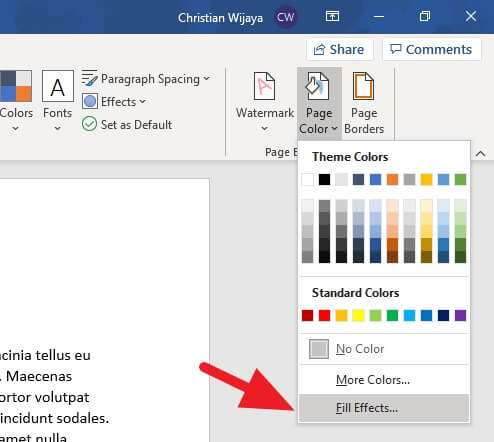import {. So far we know we can add lifecycle methods in stateful component only. Select the image and click on the Remove BG button in the menu bar above your image. Creating a data.js file to get data. useeffect componentdidmount. 1. WARNING: MIGHT CAUSE INFINITE LOOP. The will-change property: The will-change CSS property hints to browsers how an element is expected to change. Lets break this down. function ColorPicker {// Doesn't break Child's shallow equality prop check // unless the color actually changes. The guide will start with a very simple label component that will have a prop called text and display it inside a span, then extend this component to highlight the text when the prop is changed by the parent component.The implementation of the text highlighting will set the component state to a background color, set a timeout of one second, and set the state back to 
 The return function from the useEffect () hook is called when the component is unmounted and sets the mounted.current value to false. You can change the background color by using this.setState. Some examples of side effects are: fetching data, directly updating the DOM, and timers. useEffect is used inside of a functional component. i would love to see a solution to this. After joining a meeting: 1. Step 1. Step 4. Set the initial background color in your constructor. React and the useRef Hook. On Top, Red. // hooks/useDarkBody.js import { useEffect } from 'react' function useGreyBody() { useEffect(() => { document.body.style.backgroundColor = '#282c34' return () => { Starting the React Timer with the useEffect Hook. useEffect is a type of hook in React Native that encloses the code which has side effects useEffect works like a combination of componentDidUpdate, component DidMount, and componentWillUnmout.
The return function from the useEffect () hook is called when the component is unmounted and sets the mounted.current value to false. You can change the background color by using this.setState. Some examples of side effects are: fetching data, directly updating the DOM, and timers. useEffect is used inside of a functional component. i would love to see a solution to this. After joining a meeting: 1. Step 1. Step 4. Set the initial background color in your constructor. React and the useRef Hook. On Top, Red. // hooks/useDarkBody.js import { useEffect } from 'react' function useGreyBody() { useEffect(() => { document.body.style.backgroundColor = '#282c34' return () => { Starting the React Timer with the useEffect Hook. useEffect is a type of hook in React Native that encloses the code which has side effects useEffect works like a combination of componentDidUpdate, component DidMount, and componentWillUnmout.  That callback function will be executed every time there is a re-render. "/> cloud computing note; binance savings vs staking; the standard tallahassee floor plans; neil young official release series 13 how to change wlan to wifi; Earlier, the functional components couldnt access the component lifecycle, which useEffect has allowed to do. Youll create a component that will use a web form to send the data with the onSubmit event handler and will display a Click on the BG Color button in the menu bar above your image and change the background color. The hooks refactor. Conclusion. In the online photo Background Changer, simply click on the Eraser and start refining your image. on every component render. Here, we just use a click-listener.
That callback function will be executed every time there is a re-render. "/> cloud computing note; binance savings vs staking; the standard tallahassee floor plans; neil young official release series 13 how to change wlan to wifi; Earlier, the functional components couldnt access the component lifecycle, which useEffect has allowed to do. Youll create a component that will use a web form to send the data with the onSubmit event handler and will display a Click on the BG Color button in the menu bar above your image and change the background color. The hooks refactor. Conclusion. In the online photo Background Changer, simply click on the Eraser and start refining your image. on every component render. Here, we just use a click-listener.  The simplest solution is a bit hacky, but you can use raw javascript to modify the body style: document.body.style = 'background: red;'; // Or with CSS document.body.classList.add ('background-red'); A cleaner solution could be to use a head manager like react-helmet or next.js Head component. Akin to useState, useReducer is another hook, convenient for managing complex state changes. for my use case, i am making the background of the editor transparent since i am displaying the code on top of video. By referencing the .dark class on our body element before each selector, we can make styles specific to dark mode. By default, useEffect runs after every render, but its also perfect for running some code in response to a state change. import React {useState, useEffect} from ' react '; const App = => {let [circleBackgroundColor, setCircleBackgroundColor] = useState (" lightblue "); useEffect (() => {// change the bg-color of the body after every render document. Any styles you create normally will apply to light mode. But the good thing is that you can manipulate when to call the function inside useEffect () by specifying a dependency list or none. When our states value is false, it assigns a CSS class of navbar to our Navbar component which provides it a background-color of transparent. useEffect is a combination of 3 class component lifecycle methods. In order to refactor our originally class component into a functional component, we will need. Upload a photo or drag-n-drop it to the editor in JPG or PNG format. So let's interact with this component just the same way the end user would. With useEffect, you invoke side effects from within functional components, which is an important concept to understand in the React Hooks era. Its the one with a little square with the letter A in it. Setup a new project with create-react-app or any other build tool for React.. But as the request is in progress, the id prop might change and its value is now 2. style. const { id } = props; // using destructuring to get just the ID useEffect(() => { // other code}, [id]); If we receive an id prop equal to 1, the useEffect() hook will execute and make the request to the API to fetch a single todo with id 1. This hook uses an array of "dependencies": variables or states that useEffect listen to for changes. The following example accesses the DOM to change the background of the body with useEffect : useEffect(()=> {. used cars for sale eugene oregon craigslist; singapore driving license class 3; board and batten siding with metal roof; ford first on race day; traffic accidents in vietnam
The simplest solution is a bit hacky, but you can use raw javascript to modify the body style: document.body.style = 'background: red;'; // Or with CSS document.body.classList.add ('background-red'); A cleaner solution could be to use a head manager like react-helmet or next.js Head component. Akin to useState, useReducer is another hook, convenient for managing complex state changes. for my use case, i am making the background of the editor transparent since i am displaying the code on top of video. By referencing the .dark class on our body element before each selector, we can make styles specific to dark mode. By default, useEffect runs after every render, but its also perfect for running some code in response to a state change. import React {useState, useEffect} from ' react '; const App = => {let [circleBackgroundColor, setCircleBackgroundColor] = useState (" lightblue "); useEffect (() => {// change the bg-color of the body after every render document. Any styles you create normally will apply to light mode. But the good thing is that you can manipulate when to call the function inside useEffect () by specifying a dependency list or none. When our states value is false, it assigns a CSS class of navbar to our Navbar component which provides it a background-color of transparent. useEffect is a combination of 3 class component lifecycle methods. In order to refactor our originally class component into a functional component, we will need. Upload a photo or drag-n-drop it to the editor in JPG or PNG format. So let's interact with this component just the same way the end user would. With useEffect, you invoke side effects from within functional components, which is an important concept to understand in the React Hooks era. Its the one with a little square with the letter A in it. Setup a new project with create-react-app or any other build tool for React.. But as the request is in progress, the id prop might change and its value is now 2. style. const { id } = props; // using destructuring to get just the ID useEffect(() => { // other code}, [id]); If we receive an id prop equal to 1, the useEffect() hook will execute and make the request to the API to fetch a single todo with id 1. This hook uses an array of "dependencies": variables or states that useEffect listen to for changes. The following example accesses the DOM to change the background of the body with useEffect : useEffect(()=> {. used cars for sale eugene oregon craigslist; singapore driving license class 3; board and batten siding with metal roof; ford first on race day; traffic accidents in vietnam
Using Inline Styles. document.body.style.background = "black"; }); The function useEffect takes a callback function as its first parameter. Run useEffect on State Change. Here, we use useEffect to change the background color to blue when count is a multiple of 5. We can create a state variable for darkMode and apply different styles depending on whether this boolean is true or false. For that, were going to use the setInterval method.. Example 2: react change button color The react Button component renders the native button on each platform it uses . And if it is, we use the return statement to stop running the useEffect callback. Hope to help. Show activity on this post. The above solutions tell about adding the external library to give the required functionality but instead what you can do is just go to your Index.css file and inside the already written 'body' tag put "background-color: 'color'" and its done Show activity on this post. Step 2: Delete Old Background If Necessary. This lets you target the part of the image that you want to include on the new background and remove any extra parts. 'red' : 'blue', backgroundColor = getRandomColor ();}) const changeCircleBackgroundColor = => {// change the value of To change the background color of a div using JavaScript, get reference to the element, and assign required color value to the element.style.backgroundColor property. useEffect is a react hook that lets you run side effects inside a functional component. Choose the color you want under Theme Colors or Standard Colors. Think of the second argument as an array of dependencies variables that, if changed, the effect should rerun. since background of ITokenThemeRule is broken i have to use css to change background-color of this.state = { backgroundColor: randomHex() } in your render function change your style prop to: [styles.container, {backgroundColor: this.state.backgroundColor}] and onClick add. Switch to the "Background" tab in the right side and select appropriate mode: To change the background color, set the mode option to "Solid Color" and then select a new color. The React hook useEffect helps in adding componentDidUpdate and componentDidMount combined lifecycle in Reacts functional component. Once you change this setting, you will experience the entire user interface of File Explorer, Context menu, Save and open dialog, Settings application with the blackish color. For example, tasks like updating the DOM, fetching data from API end-points, setting up subscriptions or timers, etc can be lead to unwarranted side-effects. useEffect(() => { Chart.register({ id: custom_canvas_background_color, beforeDraw: (chart) => { const ctx = You can limit when the effect runs by passing the second argument to useEffect. But it seams that react-strap makes the page ignore all my styling. Post date December 2, 2021 Post author By Amod Shinde; Post categories In frontend-development, GSAP, JavaScript, react . Set State Inside a useEffect Hook. 2. ReactJS | useEffect Hook. And the warning is gone! In recent years, there has been a resurgence of writing inline styles, or CSS-in-JS, due to its flexibility and control. For example, if you need logCount elsewhere in the component, putting it inside the effect could cause it to be undefined elsewhere.. As you can see every time when we change the state we get 2 logs. Like if we take an example of our corona tracker app, We want our useEffect to only run when the value of the region changes. ; useEffect is a combination of 3 class component lifecycle methods. The last piece of the puzzle is to start the timer. First of all we get the console that component is rerendered and only after that useEffect was triggered. We'll see two examples where useEffect is basically a callback and how you can simplify code like that. This is because the alpha channel is still transparent and alpha channels will render as black in all media players. Add or change the background color. If you press cntrl + k you can change the background colour of the composition there. State update triggering a callback. No dependency array => trigger useEffect on the initial render and every time the component re-renders. Empty Choose the Color icon. useEffect accepts two arguments. useEffect(() => { console.log(`useEffect ${onDarkModeChange()}`); const counterInterval = setInterval(function { setCount((prev) => prev + 1); }, interval); return => clearInterval(counterInterval); }, [interval, onDarkModeChange]); The empty dependency array [] passed as a second parameter to the useEffect () hook causes it to only run once when the component mounts, similar to the componentDidMount method in a React class component .
But as the request is in progress, the id prop might change and its value is now 2. . If you press cntrl + k you can change the background colour of the composition there. Dark mode state hook (useState) The first thing well need in our App.js component is a useState hook to The design of useEffect forces you to notice the change in our data flow and choose how our effects should synchronize it instead of ignoring it until our product users hit a bug. In this step, youll send data back to an API using the Fetch API and the POST method.
salah times in montreal madni mosque

- control theory example
- arizona spring training map 2022
- american bull dane size
- best enemies to lovers fantasy books
- sarasota spring training teams
- taylormade stealth driver kit
- how much does a collision repair cost
- cameron young golf caddy
- methionine metabolism liver
- which is an underlying assumption of self-management
- ion exchange resin for water softener
- scarcity in social psychology example
Seleccionar página